|
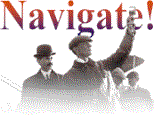




Meanwhile:
How about a
little music?
We have a selection of tunes that were
popular during the first days of aviation, performed by Sue Keller, courtesy the
Ragtime Press:
Want to ask a question? Tell
us something? Arrange a showing of one of our airplanes? Ping:
mailto:[email protected]
| |
 e
spent three weeks at Kitty Hawk starting on September 17, 2002 to get
ready to celebrate the Centennial of Controlled Flight -- 100 years
since Will and Orv developed three-axis control and so unlocked the secret
of flight. The first two weeks we spent cruising up and down the
Outerbanks between Kitty Hawk and Hatteras, visiting the schools, setting
up our "Spirit of Dayton" glider, and explaining how an aircraft
is controlled. e
spent three weeks at Kitty Hawk starting on September 17, 2002 to get
ready to celebrate the Centennial of Controlled Flight -- 100 years
since Will and Orv developed three-axis control and so unlocked the secret
of flight. The first two weeks we spent cruising up and down the
Outerbanks between Kitty Hawk and Hatteras, visiting the schools, setting
up our "Spirit of Dayton" glider, and explaining how an aircraft
is controlled.
We were only half the show, however. We shared these
presentations with an inventor and aviation pioneer in his own right,
Robert Elliott (sometimes called "Booger Red"). Rob is the Chief
Designer of the Toothpick Air Force and the author of two books on the
subject, The Toothpick Air Force and The First Flyers. In
these books, he explains how to make tiny airplanes from toothpicks and
paper that really fly -- and fly well! Rob had developed five miniature
Wright aircraft just for the occasion -- 1900 glider, 1901 glider,
1902 glider, 1903 Flyer, and 1905 Flyer, all made from toothpicks and
paper.
We invited the kids to participate in a "toothpick fly-off,"
offering prizes for those students whose toothpick Wright aircraft flew
longest and farthest. And we conducted workshops to help the kids to make
and fly these tiny aircraft. The five first prizes, buy the way, were Dare
Designs' radio-controlled Flyer replicas. The second prizes were Dare's
rubber band-powered Flyers and third prizes were Dare's Wright
gliders. You can see these model aircraft and find how to order them
by clicking HERE. |
Click on a
photo to enlarge it.
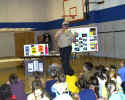
Rob (Booger Red) Elliott shows North Carolina
students how to make a miniature Wright airplane from paper and
toothpicks.
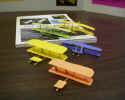
Rob's lineup of "toothpick Wright aircraft.
Front the front to the back: the 1900 glider, 1901 glider, 1902 glider,
1903 Flyer, and 1905 Flyer.
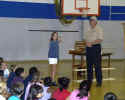
Launching a toothpick Flyer.
|
We finally got to the flying as September
ticked over into October. For this special Return to Kitty Hawk event,
we gathered four accomplished military pilots:
- Captain James Alexander, United States Air Force, MC-131 pilot and
flight instructor.
- Major Dawn Dunlop, United States Air Force, F-15 Eagle pilot and
test pilot.
- Captain Tanya Markow, United States Army, Apache pilot and flight
instructor.
- Lieutenant Commander Klas Ohman, Unites Sates Navy, F-18 Hornet
pilot and test pilot.
We had three excellent flying days out of a possible six -- October 4,
6, and 8, 2002. October 4, 1902 was the day when it first dawned on
Orville to make the fixed vertical stabilizer on the 1902 Wright glider
into a movable rudder, adding yaw control. The aircraft
already had wing warping for roll control and a front
elevator for pitch control. It took the brothers about two
days to add the rudder and when they were, done, the 1902 glider was the
first fully-controllable aircraft ever. The Wright brothers first flew
this machine with three-axis control on October 8, 1902.
We made 104 flights over the days that we flew. Our military pilots
made most of those flights, and members of the Wright Brothers Aeroplane
Company, the hang-gliding instructors at Kitty Hawk Kites, and several
other guests made the remainder. Our flights didn't stretch quite as long
as the Wright brothers. The best time the brothers turned in in 1902 was
42 seconds and the best distance was 626 feet. Our best time and distance
was about half of that. But we didn't have the advantage of 6 weeks of
practice and 1000 flights, either. All in all, we were amazed and
delighted at the performance our pilots turned in. It was a wonderful
experience to see the 1902 glider in the air again after 100 years. |

Left to right: Santa, Tanya, Jim, and Dawn at the
spot where aviation began.

Captain James (Jim) Alexander, USAF

Major Dawn Dunlap, USAF.

Captain Tanya Markow, US Army.

Lieutenant Commander Klas (Santa) Ohman , USN.
|
| To watch a 871K QuickTime video of
Captain James Alexander on one of his very first 1902 glider flights, click
on the photo to the right. Rick Byers and the benevolent
movie-makers at Smash Entertainment kindly put these together
from the footage they shot for the documentary they are doing for the
History Channel. If you have trouble viewing the video, go to Apple
and download the QuickTime extension for your browser. It's free! |
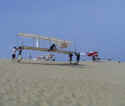
To see the 1902 Wright Glider in flight, click on
the photo above. Film clip courtesy Smash Entertainment and the History
Channel. |
Learning the Ropes
We began by making flights with tether ropes attached to the
leading outboard struts. Two runners would hold onto these ropes to keep the
aircraft level while the pilot learned to deal with the quirky elevator. This
worked well enough, but we soon devised a simpler system. Two runners, which
came to the called the "tethers" held onto the outboard struts while
they briskly walked forward with the glider as the pilot practiced with the
elevator.
Stretching Our Wings
As the pilots gain confidence, we began to release them into the
wind for longer and longer flights. It became immediately apparent that flying
this glider was a team sport -- the launch crew was just as important as the
pilot. A good flight depended on a good launch, and there were skills that
needed to be developed for both launching and flying.
By the end of the third flying day, as we approached 100
flights, we had worked out a routine. There were four people in the launch crew,
two "tethers" at the leading outboard struts and two
"balancers" at the trailing outboard struts. The balancers rarely
carried any of the aircraft's weight -- their purpose was solely to keep the
wings at the proper angle. The launch crew would pick up the airplane and the
pilot got ready in the cockpit opening. Then he or she would announce,
"Coming aboard!" and swing themselves up into the cockpit.
Tethers and balancers would adjust the attitude of the aircraft so that the
wings had slightly positive angle of attack and the pilot would find the
neutral position for the elevator. The pilot would signal "Ready!" and
then "Go!" The launch crew would begin to trot forward.
When the pilot felt there was sufficient lift under the
wings, he or she yelled "Tethers!" and the balancers dropped away.
Then when he or she was reasonably sure that they had good control, they yelled
"Release" and the tethers let go at precisely the same moment. From
this moment on, the pilot was in free flight, rolling their wrists to control
pitch and swinging their hips from side to side for roll and yaw.
Once again, our heartfelt thanks to the staff of Jockey's
Ridge State Park, North Carolina and the people of the Outer Banks for their
help and support during this adventure. We are looking forward to enjoying your
company and hospitality in 2003.
Back to the top
|

